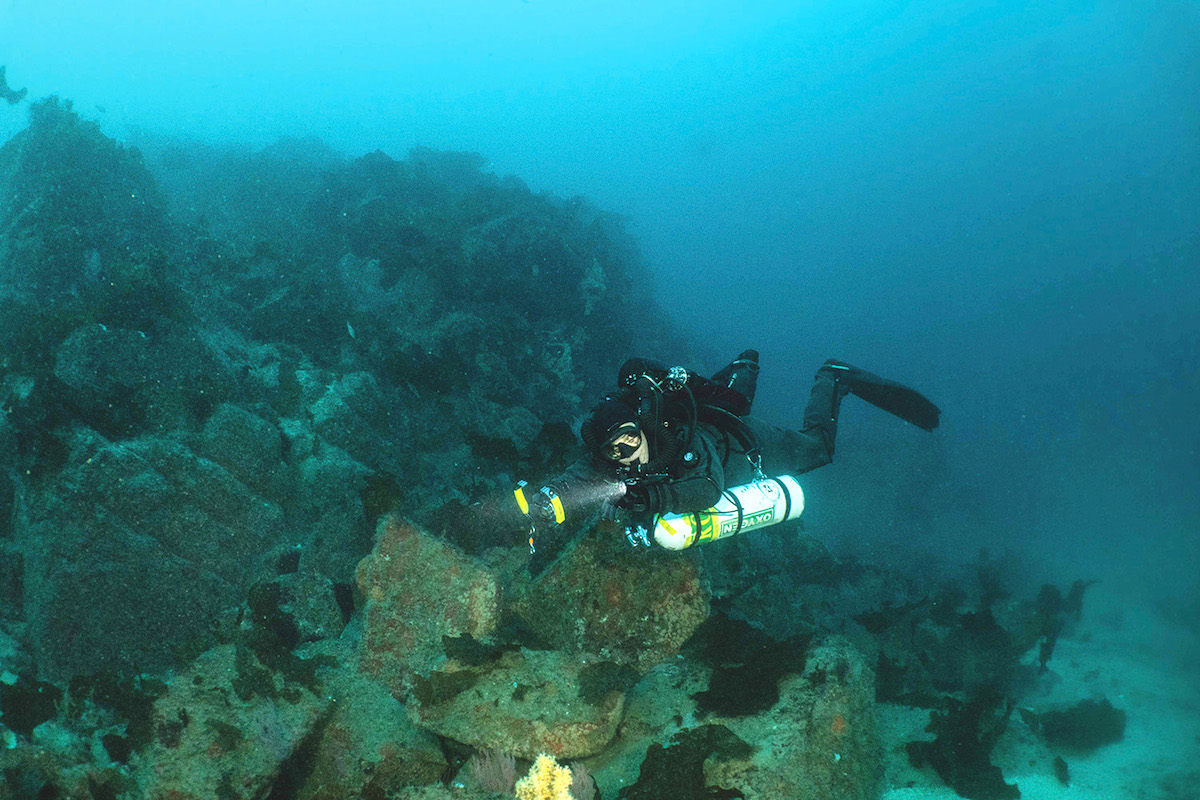
This post was originally published on this site
A guide to year-round water sports in Laguna Beach.
By Ashley Breeding
While it’s unknown exactly when surfing started, Polynesian cave paintings dating to the 12th century show people riding waves. Then, in 1778, Capt. James Cook became the first European to see people surfing in the Hawaiian Islands. Eventually, the sport made its way to California in the late 1800s.
Laguna Beach native Dick Metz, 92, who now splits his time between Laguna and Idaho, grew up during the Great Depression, when “we didn’t have any materials and there weren’t more than 100 people on the West Coast that surfed,” he says.
“… If you wanted a board back in those days, you’d have to make it yourself or have a friend do it for you,” recalls Metz, noting how early shapers like Peanuts Larson and Herb Elke in Laguna would spend an entire month or two on the beach making one board. Constructed mostly of redwood and lacking a fin, boards were big and heavy and hard to maneuver. There was no such thing as a wetsuit, so local surfers, like Metz, would share a board, taking turns for as long as they could tolerate the biting Pacific waters.
“Then World War II happened, and surfing stopped entirely,” says Metz, explaining that all the young guys were away serving in the military. However, development of chemicals and materials during the war—fiberglass, resin and plastic foams—would radically enhance board design and reshape surfing after the 1940s.
In the late 1950s, Metz took a three-year trip around the world, hitchhiking and working on ships to reach surfing spots from Tahiti to Australia and Cape Town, South Africa, and would go on to inspire the film “The Endless Summer” and establish the Surfing Heritage & Culture Center in San Clemente.
Hobie Alter, an avid sailor whose family summered in Laguna, took an interest in surfing after watching Metz and his friends at Brooks and Oak streets, and soon began building boards in his dad’s garage. By now they were made of balsa wood, which was lighter than redwood but also porous. By wrapping balsa wood in fiberglass, Alter made it waterproof. He could now also attach a fiberglass fin, enabling much faster turns on a wave.
“On the old redwood boards, we’d have to stand on one leg and drag a foot in the water to turn our board even slightly,” Metz points out. “Now we could change direction real easy, just by shifting our feet and weight.”
Read on for tips about surfing and other water sports to try in Laguna, plus the best spots to get your feet wet.
Surfing
Fast-forward to the late 1950s and Alter perfected a foam-and-fiberglass process that revolutionized surfing for the masses, and it became a professional sport around 1960. “With these lighter and more maneuverable boards, you could now surf more breaks and locations,” Metz says. “In the 1970s, the shortboard revolution came about and divided the sport in two.
“You now had these young, hot guys using shortboards on fast-breaking waves,” Metz continues. “It’s not unusual for a professional surfer these days to have a quiver of boards, all different shapes for different locations and conditions.”
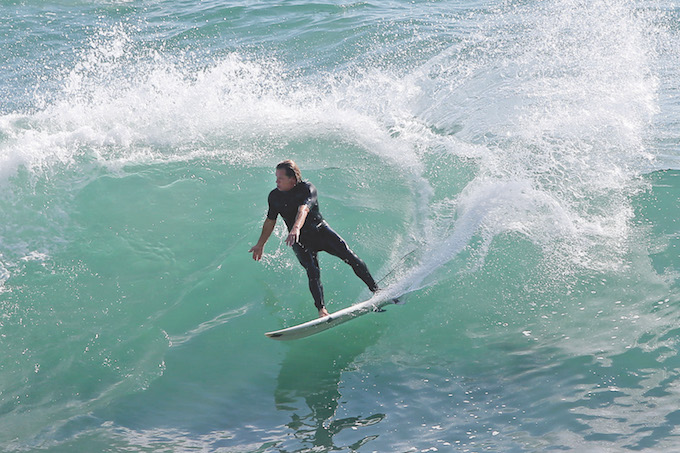
Since Laguna’s short, fast-breaking waves aren’t ideal for beginners, many start out in nearby Doheny or San Onofre state beaches, where “waves break far from the shore and roll in, giving you plenty of time to get to your feet and ride in,” explains Brandy Faber, a Laguna Realtor, former professional surfer and lifelong resident. Those who don’t want to make the drive can head to beaches at Thalia and Oak streets, which have gentler breaks and are the location for Laguna’s surf schools. At the south end of Thalia Street, go to the left of the stairs to Hakama, a surf break rumored to have been named by a Hawaiian guy in the 1950s or 1960s because it breaks in the opposite direction of Makaha on Oahu, Faber says.
For experienced surfers, Brooks Street—where the annual Brooks Street Surfing Classic is held—and Rockpile (below the Heisler Park cliffs, just north of the gazebo) serve up the most excitement.
Gear up: All you need is a board, fins, a leash and a wetsuit.
Skimboarding
Eager to ride fast, shallow breaks not fit for a surfboard, a couple of Laguna lifeguards in the 1920s had the idea to use redwood planks (held together with two oak bands) that they could ride to slide, bounce and skip across the water from one tower to the next. Back then, it was called “skidboarding.” It would be another 30 years—around the same time that surfing exploded on the West Coast—before a more effective board design came about and “skimboarding” spread in popularity.
“With the invention of plywood for World War I, many round skimboards were manufactured and sold all over the U.S.,” says Tex Haines, owner of Victoria Skimboards in Laguna. “Riding back and forth on a flat beach doing spinners was the norm. But, Laguna has steeper beaches and the waves actually come all the way to the beach before breaking, unlike most beaches in Southern California where the topography is generally flat. So by the mid ’50s, the locals in Laguna had stretched out the [boards] … into more oblong shapes with parallel rails that made turning the board possible.”
When Haines got into the sport at age 11 in 1961, people at Victoria Beach “were riding right … to the shorebreak and pulling off huge turns and big flips on wooden boards,” he says.
In 1976, Haines and friend Peter Prietto launched the first official skimboarding brand, Victoria Skimboards, a nod to the beach where they learned to ride. After that, the sport expanded globally, and Aliso Beach—considered one of the world’s premier locations because of its “easy access, bigger swell and constantly moving sand,” thanks to Aliso Creek, Haines points out—became host to The Vic, an annual skimboarding competition started by Victoria Skimboards.
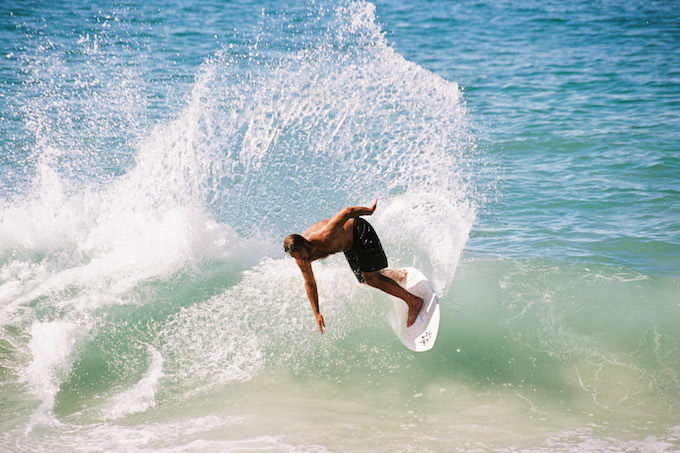
When just starting out, Haines suggests the beach at the end of Thalia Street, which is much closer to downtown Laguna with waves that are usually a foot smaller than Aliso Beach on any given day. “So when the swell is small and the tide is high, Thalia is the go-to spot for the younger skimboarders,” Haines says.
Why choose skimboarding over surfing? “No crowds is a huge factor,” Haines says. “No hassles for waves, way more rides, tons more camaraderie with your buds on the shore, and a board is all you need. And even an inexpensive wood board is more than enough to learn on. No lift tickets, no expensive clothing, plenty of sun and fresh air, what more do you want? Friction-free sliding with no real control until you hit the water produces a lot of adrenaline.”
Gear up: All you need is a skimboard, a wetsuit (in the colder months), and a backpack to hold items like wax, sunscreen and a water bottle.
Stand-Up Paddleboarding
While stand-up paddleboarding may have started in various places around the globe, modern SUP’s roots—like those of surfing—trace back to Polynesia sometime in the 18th century, but big-wave surfer Laird Hamilton was pivotal in raising the sport’s popularity in California, says Erin O’Malley, owner of Sunset Stand Up Paddle, which offers lessons, rentals and coastline tours.
As Laguna’s surf culture grew in the mid-1900s, so did SUP—the act of propelling through the water with a paddle while standing on a floating board (wider and longer than most longboards for surfing). Great for both staying fit and sightseeing, SUP in Laguna offers ample opportunities to see a diverse array of marine creatures. “The coolest thing I’ve seen was four or five gray whales down near Montage, just hanging out and scrubbing their backs in the sand,” O’Malley recalls. “They swam underneath and around us for an hour.”
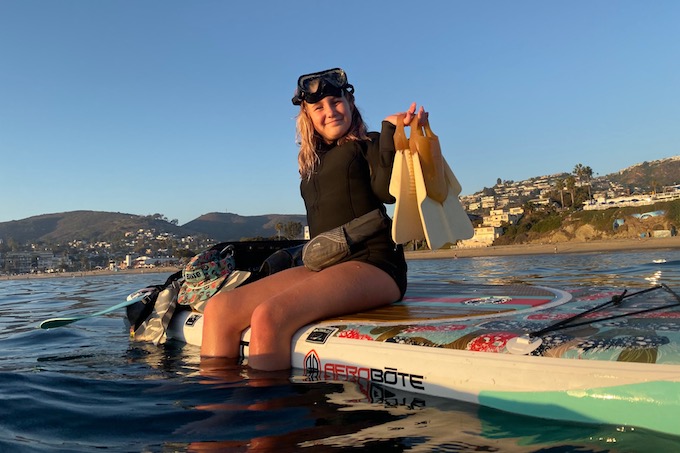
Paddling out for the first time? Start at Fisherman’s and Divers coves, or any protected area where the water is calmer, O’Malley advises. “Exposed shoreline is harder to navigate over the surf line, so don’t go there until you’ve learned to find your balance and are able to read and time the sets of waves,” she says. And no matter your level and experience, O’Malley recommends wearing a leash (to keep you and your board together) and a personal flotation device. “Before heading out, talk with a local ocean sports shop or an experienced local paddleboarder, who knows the waters well and can help you get a read on the environment,” she adds.
Gear up: a board and paddle, a rash guard, hat, leash and PFD for safety and a dry bag backpack to carry items like sunscreen. O’Malley also relies on the Windy app for hourly forecasting on weather, swells, currents and tides. Other options include the Windfinder or Surfline apps.
Scuba Diving and Snorkeling
Retired Marine and avid diver D.J. Mansfield came to Southern California when he was stationed at Camp Pendleton and fell in love with the area. In 2000, he started working for Beach Cities Scuba, an outfitter that offers lessons and rentals, and has now been training novice divers for more than 20 years.
For about a decade, the ocean off Laguna’s coast has been a no-take Marine Protected Area, “which has created a massive and beautiful reef system all up and down the coastline,” Mansfield notes. He’s drawn to the city’s northern coves like Shaw’s and Fisherman’s. “Northernmost [beaches] are typically more protected, [but] all of Laguna’s coastline is among the best diving in the region,” he says.
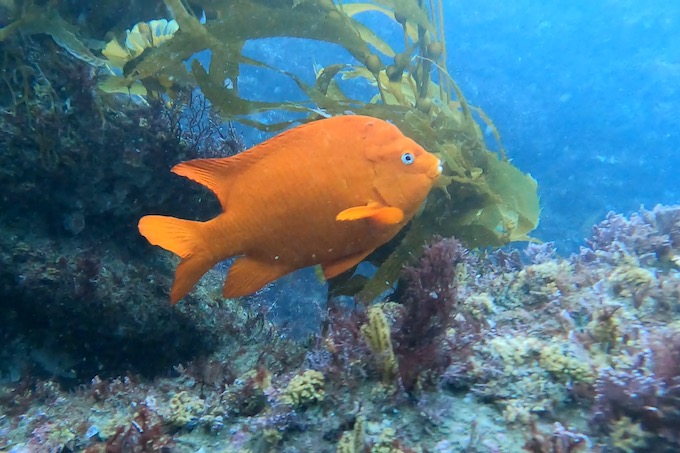
A healthy kelp bed attracts diverse sea creatures, and Mansfield describes swimming among bright orange garibaldi (the state marine fish), which is both abundant and noticeable, as well as white sea bass, docile blue sharks, sea lions, harbor seals, bat rays and more.
“When you’re talking about species and concentration, this is one of the most populated regions,” he notes. “There’s even the opportunity to see bigger animals come in to hunt for smaller fish like the [California] sheepshead and the senorita, [‘cleaner fish’ that remove parasites from other fish].”
In addition to scuba diving, snorkeling at the water’s surface provides some of the same opportunities to observe sea life. “Any cove that allows for easy entry is a suitable area,” he says. “Divers Cove, Fisherman’s Cove [and] Shaw’s Cove on good days are among the top diving sites to see in SoCal.”
Gear up: If you’re scuba diving, you’ll need some training before you can let loose: That includes about five hours of online learning, five or six hours in the pool and then four ocean dives spread over two days to receive lifetime certification. In addition to all the standard gear, Mansfield wears the latest, solar-powered Garmin Descent G1 diving watch with GPS capability.
Free Diving
For Faber and other surfers, noncompetitive free diving (holding your breath as you move freely underwater) has added benefits, like conditioning your mind to remain calm in stressful situations. “If we get held under a big wave or heavy water, we have that training to draw from,” Faber explains. “That’s why it’s common to see big-wave surfers who are also free divers.”
Like Faber, wildlife sculptor Casey Parlette grew up free diving off of Laguna’s coast, “supplementing our diets with stuff we’d find in the ocean,” he says. That was before the ocean off Laguna’s coast was an MPA, though some adjacent waters still allow spearfishing and lobster diving, where he still goes today.
Parlette mainly free dives for “the connection to the ocean and all the life that’s out there,” he says. “It’s a way to enter a new environment and get comfortable in it so you can really observe what’s around you … whether it’s huge schools of fish or just watching the weird stuff that octopuses do.” He also swam beside a blue whale once. “That was pretty cool,” he says. “‘… It came within about 10 feet from me. They look especially big underwater.”
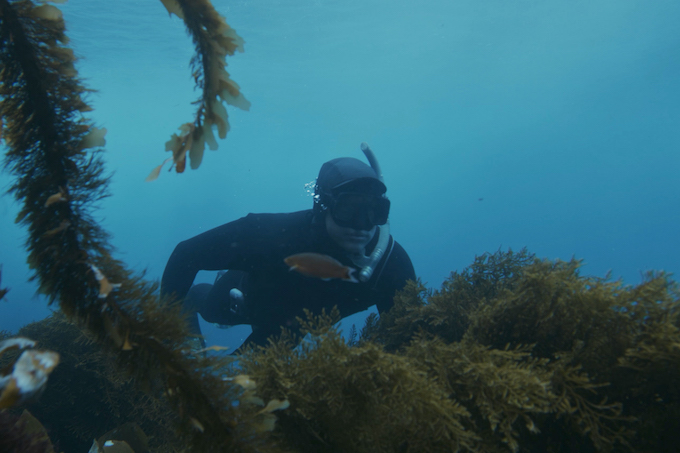
Parlette likes to take his son out on the family rowboat, teaching him to snorkel and cultivate appreciation for the ocean environment. “Seeing it with a 5-year-old is like seeing it all again with fresh eyes,” Parlette points out. He’s explored seas around the world, but Laguna holds a special place for him.
“I was fortunate enough to do underwater film work for ‘Inside Sportfishing,’ a TV show about fishing,” he adds. “There’s some amazing places out there, but some of my favorite dives ever were in Laguna on those great, clear days come along every once in a while.”
Parlette says the best place to go diving depends on the day. “Every single beach in Laguna has great diving—you never know where the wildlife is going to be.”
Faber says Wood’s Cove, Treasure Island (below Montage Laguna Beach), Fisherman’s Cove and Shaw’s Cove are all popular dive spots.
Gear up: Have a wetsuit, mask, snorkel, fins, patience and a keen eye when free diving.
Kayaking
If paddling out with a boat between you and the water’s surface is more your speed, kayaking is an ideal way to explore Laguna’s coastline.
For those just starting out, La Vida Laguna offers kayaking tours with experienced guides, launching out of a protected coves. Glide on the water above dense kelp forests and keep an eye out for marine mammals, birds and abundant wildlife that circle these waters.

The Southern California area is also home to one of the largest blue whale and dolphin populations, making a sighting likely for local ocean adventurers. Laguna is also on the migratory path for gray whales, which have served up many an appearance to Laguna kayakers. A favorite spot for guides is Seal Rock, where a colony of California sea lions can often be admired from your boat.
Gear up: La Vida Laguna provides the kayak, the paddle and the life vest. Bring quick-dry clothing, sun protection and a thirst for adventure.
